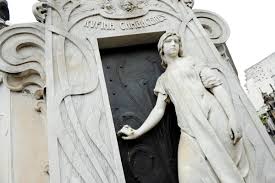Ghost Stories in the Recoleta Cemetery
The Legend of the Ghost Keeper
In 1910, a man working the night shift at Recoleta Cemetery took his own life. His name was David Alleno, an Italian immigrant who had worked as the caretaker of the tombs for 29 years. From the moment he started the job in 1881, he dreamed of being buried in the cemetery. He saved money to buy a lot, built his own grave, and even commissioned a sculptor from his hometown of Genoa to carve his likeness. Once everything was ready, he died by suicide.
Night watchmen who have worked at the cemetery over the years tell stories of his ghost — never seen, but heard. The jingling sound of his keys, used to check the tombs, is said to announce his presence.
Rufina Cambaceres
In a corner of Section 13 lies the grave of Rufina Cambaceres, beside that of her family. This unfortunate young woman might be the famous “Lady in White,” or perhaps the female ghost said to wander the cemetery at night.
Rufina died unexpectedly at the age of 19, in May 1902. She was buried in the family tomb, but a few days later the caretakers noticed that the coffin had shifted and alerted the family. When the casket was opened, Rufina was found covered in bruises and scratches. It is believed she had been buried alive.
According to one version, Rufina’s mother used to give her tranquilizers each night so she could secretly meet with her lover — who was also Rufina’s boyfriend. On the night of Rufina’s supposed death, her mother may have given her a double dose.
A year later, the family commissioned an Art Nouveau tomb. The statue of Rufina stands at the entrance, her hand on the door handle, as if ready to walk out. Hers is the only tomb in the cemetery made from a single block of marble from Milan.
More rational versions of the story claim that grave robbers disturbed the coffin in an attempt to steal jewelry.
The Lady in White
Luz María García Velloso died of leukemia in 1925, at the age of just 15. Her tomb is located to the right of the cemetery’s main path. There lies a statue of a beautiful young girl, lifeless on her bed. Her mother, stricken with grief, is said to have slept for months at the foot of the statue, in a small space behind the bars.
One of Buenos Aires’s most well-known urban legends is linked to Luz María: the story of the “Lady in White.” According to legend, a young man meets a beautiful girl and takes her out. When she says she’s cold, he lends her his coat. She accidentally spills coffee on it. The next day, when he returns to her house to retrieve his coat, her mother tells him that the girl has been dead for some time and is buried at Recoleta Cemetery. He rushes to the cemetery and finds his coat draped over her grave. In some versions, the young man goes mad or dies by suicide.
In another version, there is no visit to the girl’s home. Instead, the young man follows her into the cemetery, only to see her vanish among the tombs — and realizes she was a ghost all along.
The Argentine actor Arturo García Buhr claimed to have known her. The story was adapted into film twice: first in 1942 as El fantasma de Buenos Aires (Ghost of Buenos Aires), and again in 1950 as Una mujer ha entrado (A Woman Has Entered), directed by Carlos Hugo Christensen.
For years, young men in Buenos Aires have avoided picking up girls near the corner of Vicente López and Azcuénaga.

